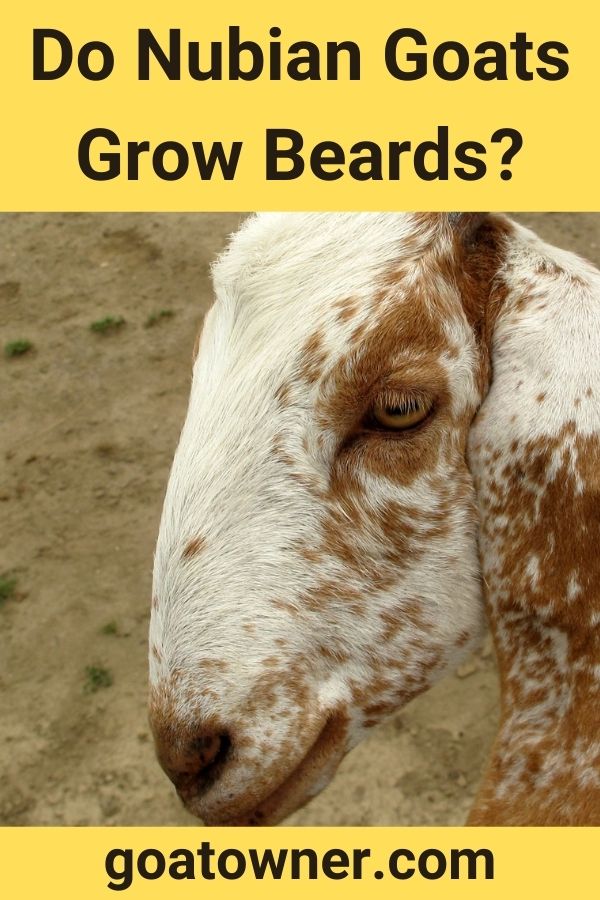One of the most universally recognized features of goats is their magnificent, flowing beards.
They come in all sort sorts of different sizes and styles, since goats always like to stay in vogue!
Though most goats have a beard of at least some size, this is not true of all breeds, and certainly not true of all individuals.
One goat I have always been fond of is the Nubian (or Anglo-Nubian) goat.
Their huge, swaying ears and dark coats are very beautiful and they come in a wide variety of shades.
However, a friend thinking of getting a Nubian goat herd asked me about their beards, so I decided to do some research and add some knowledge to my personal experience.
So, do Nubian goats grow beards?
The simple answer is not always. Typically, the bucks will grow a beard of some length, while the does may not grow a beard at all. This is not always true, however, and many goat owners report that they have never seen a Nubian, male or female, with a beard!
Regardless of breed, most male goats do grow beards.
I’ll get into exactly why goats grow beards soon, but as far as Nubians go specifically, you will have to accept that there isn’t necessarily a universal answer.
Individuals vary a lot, and it seems like Nubians are less likely to grow a beard than many other breeds.
Why do goats grow beards?
You may be wondering why it’s the case that bucks grow beards where does, generally speaking, do not.
The simplest answer is that the beard represents what is called sexual dimorphism, which is the phenomena in which the two sexes of a species differ greatly in appearance.
In other words, bucks use their magnificent beards to attract mates!
The beard represents energy spent on growing a non-vital organ; goats do not need their beards to survive, after all.
This is rather a simplification of the use of sexual displays by male animals trying to attract mates, but this is, in the most basic sense, what it comes down to.
Females choose mates on the basis of how healthy they are, since these genetics will give their offspring the best chance of surviving and reproducing themselves.
Goats are no different.
They are herd animals, meaning that they don’t have to do as much work as other species to attract mates; some birds have to do the most incredibly elaborate dances in order to get a female to show interest in them.
Goats have females readily around them looking for a mate, but they will need to look to the buck’s beard to know which one makes the best match.
Think about the impressive mane of a male lion, compared to the females who don’t have manes; or the brilliant plumage of a male peacock, compared to the dull brown of the females.
You may be wondering, then, if Nubian goats are known for not often growing beards, how a female would choose a mate.
Well, it all the more demonstrates that a male with a beard would be set apart from the herd.
However, there are other factors females will look for, like simple size and energy levels.
At what age do goats get beards?
Kids are not born with beards, or at least if they are, it is barely noticeable for the first year or two of its life.
It will just be a little tuft of hair.
Certainly, in Nubian goats you will not be able to see much of a beard at first.
After a year or so you will begin to notice little tufts, and this will lengthen and thicken with age.
By the time its two or three years old, the goat’s beard will likely have grown as much as it will in most breeds.
Again, depending on breed, your goat will usually have passed its prime by about age 5 or 6, so if it doesn’t have a beard by then, it is unlikely to ever develop one.
If your Nubian goat is going to grow a beard, it may come in slightly later, but in general all the same will apply to a Nubian as to any breed.
Do other animals have beards?
Goats are not the only animals with beards, and impressing females is not the only reason animals have beards- although it is the most common.
Lots of primates – including us! – grow beards for this purpose.
The iconic bearded emperor tamarin has a stunning, flowing white moustache which reaches like whiskers either side of their faces.
Since both males and females have these moustaches, it’s thought they help identify different members of a group.
Male orangutans also sport impressive red beards, which is a clear sign of sexual readiness for the males, indicating they have reached maturity.
These can take years to develop but will be very popular with female orangutans.
Other animals that live in colder climates sport beards for the purposes of insulation.
Bison and Himalayan markhors (a close relative of goats) both sport huge, bushy beards to keep warm in cold weather and at high elevations.
This could also be true of humans, in fact; thick, long beards would have kept our ancestors warm during the long ice age.
So, to wrap up, then, it does seem Nubian goats are less likely to grow beards than other breeds.
It’s not impossible or even uncommon, however.
Comparatively speaking, they have beards much less frequently than other breeds, who may even universally have beards.
Female Nubians will almost certainly not grow beards, and males could but it is not guaranteed.
If you’re especially keen on the beard aspect of goats, then perhaps a different breed would be best for you.

